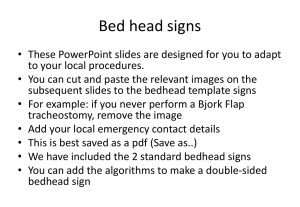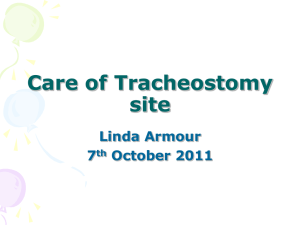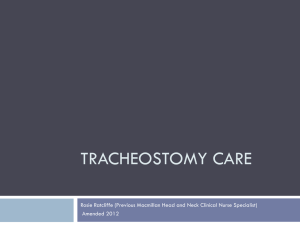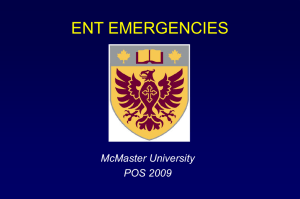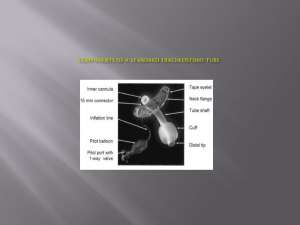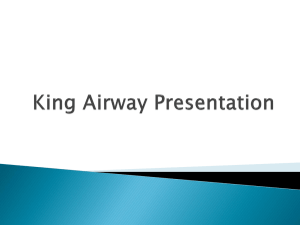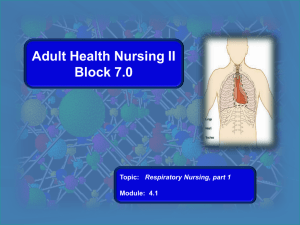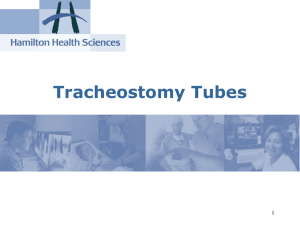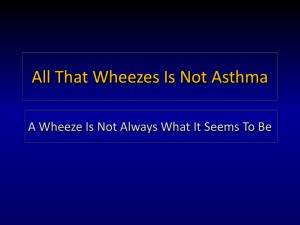Laryngectomy V`s Tracheostomy Implications for
advertisement
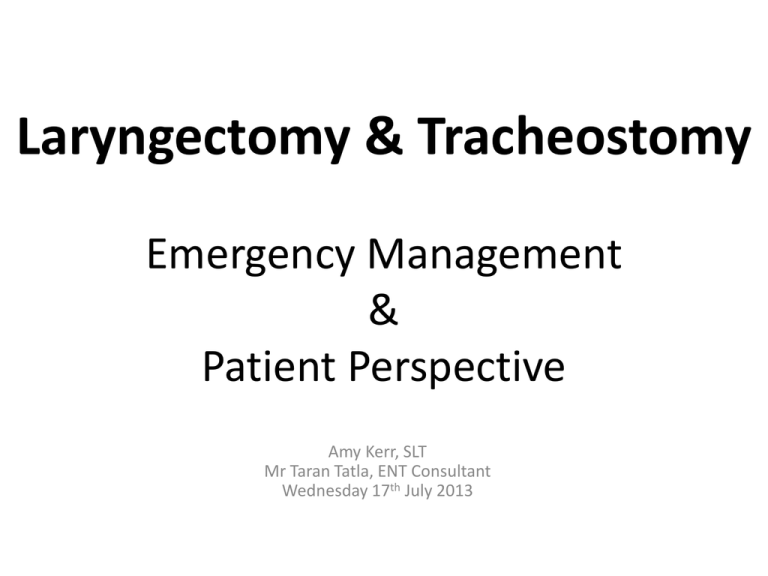
Laryngectomy & Tracheostomy Emergency Management & Patient Perspective Amy Kerr, SLT Mr Taran Tatla, ENT Consultant Wednesday 17th July 2013 Altered Airway • Huge impact on people’s lives • Discoordinated care can result in dangerous, potentially fatal situations • Practices variable • Awareness & knowledge can be lacking • Catastrophic events – Opportunity to do better Artificial Airway Incidents • Majority due to airway loss: – Displaced trache – Tube occlusion (partial or complete) – Airway obstruction / stenosis • Potential factors: – Lack of staff education – Confusion with anatomy – Lack of equipment / resources What is the purpose of an Artificial Airway? • • • • • Provide adequate ventilation and oxygenation Maintain a patent airway Eliminate airway obstruction Reduce the potential for aspiration Provide access for secretion clearance Normal anatomy Tracheostomy Laryngectomy Total Laryngectomy • Removal of larynx • Separation of trachea from oesophagus • Permanent stoma Contributing factors to an emergency • • • • • • • • • • Over production of sputum Coughing Irritation of trachea Undue movement of the tracheostomy tube Multiple suctioning attempts Dry, hardened secretions Sputum plug blocking airway or tracheostomy tube Cuff integrity compromised Aspiration of stomach contents Dysphagia National Patient Safety Agency • Approached by the National Association of Laryngectomy Clubs – due to concerns re: emergency care • 171 surveys returned National Patient Safety • 26/171 patients required ambulance assistance and felt that staff didn’t have the right equipment available. • 30/171 patients required emergency treatment in hospital and felt that the hospital staff did not know how to manage their specific needs. • The main concerns for both were lack of: • Tracheostomy masks for delivering oxygen • Suction units for clearing stoma • Tracheal forceps to remove plugs • A patient wrote of his experience in A+E with chest pains. “The nurse was going to give oxygen. I told the nurse I was a neck breather and she then said put the mask on him and we’ll force the air down” Emergency Management • • • • • Ventilation Suctioning Aspiration Loss of airway Cardiopulmonary resuscitation Ventilating Tracheostomy vs Laryngectomy patients • Via the stoma* / tracheostomy ^ • Trache patients – inflate cuff to form seal • Laryngectomy – insert a trache/endotracheal tube into stoma and inflate cuff • *never via the mouth for a laryngectomy • ^must not forget standard oral airway manoeuvres in an emergency with an obstructed tracheostomy Suctioning • Tracheostomy: – ensure non-fenestrated inner cannula and suction via the tracheostomy • Laryngectomy : – suction via the stoma, no need to place tracheostomy tube. Aspiration – Tracheostomy • Reduce risk by changing to a cuffed tube and inflating cuff, change to a non-fenestrated inner cannula • NB: inflating cuff will help reduce aspiration of secretions but not completely eliminate • Request SLT assessment • If chronic consider use of medication to reduce secretions Aspiration - Laryngectomy • If no Surgical Voice Restoration (SVR), very low risk unless recent Head & Neck Surgery Total Laryngectomy - SVR • If patient has SVR then ensure; – The voice prosthesis is in place – if dislodged and you are able to see the tract – place catheter – Is the voice prosthesis leaking? If it is leaking continue NBM and request SLT assessment Loss of airway • Tracheostomy: • Suction – if unable to pass catheter remove inner cannula – remove secretions • If still unable to pass catheter patient may require a trache change – Consider positioning of trache, type of trache • Remember standard oral airway manoeuvres Loss of Airway • Laryngectomy: • • • • Place tracheostomy / endotracheal tube via stoma Laryngectomy tube (monitor stoma size) Suction as required Humidification: – Regular nebulisers – Humidified oxygen – Ensure adequate hydration to thin & loosen secretions • Speaking valves (e.g. Passy-Muir) NOT for use with laryngectomy patients! Cardiopulmonary Resuscitation • Tracheostomy: • Inflate cuff (if tube not blocked or displaced) • Bag ventilate via tracheostomy tube connector (catheter mount) • If the tracheostomy tube is removed due to blockage/ displacement & unable to be replaced: – If the upper airway is patent, cover the stoma (swabs/ hand) and ventilate via the upper airway (e.g. Bag-valve-mask) – If the upper airway is not patent, ventilate via a paediatric mask or laryngeal mask airway (LMA) applied to the stoma • Compression to breath ratio 30:2 Cardiopulmonary Resuscitation • Laryngectomy: • Bag via stoma using a paediatric mask or LMA • Insert a trache / endotracheal tube and inflate cuff to form seal • Compression to breath ratio 30:2 UK National Tracheostomy Safety Project NTSP www.tracheostomy.org.uk Reproduced from McGrath BA, Bates L, Atkinson D, Moore JA. Multidisciplinary guidelines for the management of tracheostomy and laryngectomy airway emergencies. Anaesthesia. 2012 Jun 26. doi: 10.1111/j.13652044.2012.07217, with permission from the Association of Anaesthetists of Great Britain & Ireland/Blackwell Publishing Ltd." Reproduced from McGrath BA, Bates L, Atkinson D, Moore JA. Multidisciplinary guidelines for the management of tracheostomy and laryngectomy airway emergencies. Anaesthesia. 2012 Jun 26. doi: 10.1111/j.13652044.2012.07217, with permission from the Association of Anaesthetists of Great Britain & Ireland/Blackwell Publishing Ltd." Reproduced from McGrath BA, Bates L, Atkinson D, Moore JA. Multidisciplinary guidelines for the management of tracheostomy and laryngectomy airway emergencies. Anaesthesia. 2012 Jun 26. doi: 10.1111/j.13652044.2012.07217, with permission from the Association of Anaesthetists of Great Britain & Ireland/Blackwell Publishing Ltd." Reproduced from McGrath BA, Bates L, Atkinson D, Moore JA. Multidisciplinary guidelines for the management of tracheostomy and laryngectomy airway emergencies. Anaesthesia. 2012 Jun 26. doi: 10.1111/j.13652044.2012.07217, with permission from the Association of Anaesthetists of Great Britain & Ireland/Blackwell Publishing Ltd."
